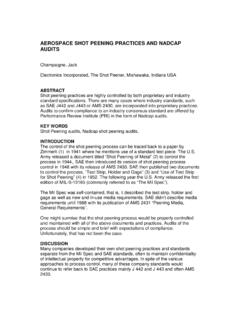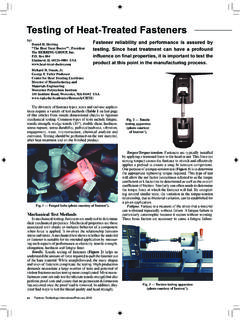Transcription of AN OVERVIEW OF SHOT -PEENING
1 International Conference on Shot peening and Blast Cleaning AN OVERVIEW OF SHOT - peening A Niku-Lari IITT, France. ABSTRACT Controlled shot -PEENING is an operation which is used largely in the manufacture of mechanical parts. It should not be confused with sand blasting used in cleaning or descaling parts. Shot -PEENING is in fact a true machining operation which helps increase fatigue and stress corrosion resistance by creating beneficial residual surface stresses. The technique consists of propelling at high speed ~mall beads of steel, cast iron, glass or cut wire against the part to be treated.
2 The size of the beads can vary from to or even 2mm. The shot is blasted under conditions which must be totally controlled. The main advantage of this particular surface treatment is that it increases considerably the fatigue life of mechanical parts subjected to dynamic stresses. It has many uses in industry, particularly in the manufacture of parts as different as helical springs, rockers, welded joints, aircraft parts, transmission shafts, torsion bars, etc. At a time when the optimum characteristi_cs are being demanded of mechanical assemblies, shot -PEENING is a surface treatment method which is being increasingly chosen by engineers.
3 However, shot -PEENING technology is yet to be fully perfected and the substantial changes produced in the treated material make it difficult at the present time to put the best conditions into practical use. KEY WORDS residual stress , surface roughness, stress relaxation, , Shot-velocity, Shot-hardness, Intensity, Fatigue. 1. THE TECHNOLOGY OF SHOT -PEENING Shot -PEENING Machines There are numerous types of shot -PEENING machines. Those can be divided into two categories, dependent on the method used for projecting the shot, compressed air or wheel, The choice between these two types of machine wiil depend on the quality of the shot-p.
4 , required and the type of part which is to be treated. Shot-peeni,:ig machines can also vary considerably in the way the part is positioned in the stream of shot. There are thus drum-type machines for shot -PEENING patrs in bulk, rotating table machines for small parts in series, linear conveyors for helical springs, and overhead conveyors (see schematic representation). Computer-controlled machines now exist with which different surfaces of the part may be treated with varying intensities. Finally, for certain cases, the shot -PEENING of welded joints on off shore pipelines for example, there are portable units.
5 Uncier these conditions, the shot -PEENING has to be manual, with a special system for recycling-the shot. Like the .choice of the machine, particular importance lies in the choice of the shot, which, literally, represents the tools used for this type of su'rface treatment. : ; Schematic Representation of Some Conveyor Systems When it is required to choose a quality of shot for a surface-hardening operation, several factors must be taken into account(1 ) . -The shot -PEENING installation and the shot used must produce the required intensity within a reasonable time.
6 -The surface roughness which results must be within the required tolerances. -The depth of plastic deformed layer in the metal and the maximum residual stress must be such that the fatigue resistance is improved to the required extent. -The life of the shot must be adequate fro"m a financial point of view. -The shape of the shot must remain as close as poss Ible to the spherical, to avoid the formation of surface micro-cracks in the part, where stress concentrations 2 would be generated in service.
7 Different types of shot exist for use in shot -PEENING treatments. Among these may be mentioned: Cast steel shot with a hardness of 40-55 HRC, the type most frequently used for strain hardening operations by shot -PEENING . Glass beads used for delicate strain hardening op-erations such as on parts with slim shapes, the-strain hardening of light alloys used in aircraft manufacturing, and the protection of stainless steels against stress corrosion cracking All Almen intensities. in this work are obtained on an A-strip.
8 The values of the Almen intensities are given either in mm or in 1/100 of an mm. Examples: -Almen intensity = mm. -30A2 means Almen intensity = mm. In order to convert these values to the SAE standard one should multiply them by 40. Almen intensity mm = 1 OA2~ ,, .. mm = 20A2~ 4A BA " .. 0,3 mm = 30A2~ 12A Cut wire used in a previously rounded condition, mainly in Germany, Japan and China, owing to be the stability shown by its mechanical characteristics during the shot -PEENING operation. This type of shot is.
9 Relatively little-used in France and the USA. Cast-iron shot, little-used for strain hardening operations owing to its fragility and tendency to shatter. Refractory electro-cast balls - a shot -PEENING agent, developed in France, which can be used under the same conditions as those for gla_ss beads, whi_le retaining its characteristics for a longer period. Various standards exist which define the quality and grain sizes for these different types of shot (3) 2. CONTROL OF THE OPERATION AND FUTURE DEVELOPMENT Very many parameters are involved in shot -PEENING .
10 Among them are: -the shot speed -the dimensions, shape, nature and hardness of shot, -the -projection angle, 3 -the exposure time to shot -PEENING , -coverage. 0 .1 This multiplicity of parameters makes the precise control and repeatability of a shot -PEENING very problematical. Control of shot -PEENING opera-tions for strain currently achieved by means of th~ Almen gauge system (see footnote). For. this a steel test piece, precisely defined and standardised by American Military Standards (2), is subjected to shot -PEENING .



